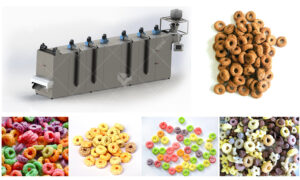Home > Food Processing > The production process of breakfast cereals

The production process of breakfast cereals
June 17, 2023Introduction :
Corn flakes production line is also called breakfast cereal corn flakes production line, corn flake /breakfast cereal is one kind of crispy food, with the advantages of hard to be steeped broken and strong grain taste. It is the crispy flake which is made from corn meal and the other grains powder. The production line includes mixing, extruding, flaking, drying, high temperature baking, flavoring and cooling. It can be eaten like snack, and be eaten with milk or coffee as well. By changing moulds and production process, this production line can make different shapes of puffed food. Such as ring, ball, flake, star, letter etc.
Breakfast cereal is a type of processed food made of grain and intended to be eaten with milk as a main course during the morning meal. The two main types of breakfast cereals are defined by the way they’re eaten. Hot cereals, for example, require a brief cooking period but are less popular than the cold, ready-to-eat cereal. Hot cereal recipes have existed, in one form or another, since ancient times when people would grind whole grains and cook them in water to create various forms of gruels or porridge.
Cold cereals, on the other hand, were developed much later in the late 19th century. To some extent, they were invented because of religious beliefs. The precursor to what most of us today know as cereals was developed by the American clergyman Sylvester Graham, who was a strong advocate of a vegetarian diet. In 1829, he used coarse and unsifted ground wheat flour to create the Graham cracker.
Fast-forward several decades, and we have Dr. James Caleb Jackson, who invented the very first cold cereal called granula in 1863. Similar to Graham, Dr. Jackson was a proponent of a vegetarian diet and the eating of unprocessed foods. He was well aware of the effect that nutrition has on a person’s health and eventually created a dry, whole-grain breakfast cereal. The recipe was rather simple. He baked graham flour and bran and crumbled it. That said, granula was too hard to eat “right out of the box” and required about 20 minutes of soaking in milk or water. Nevertheless, this was faster and more convenient than was the case with hot cereals that required actual cooking.
Several years after the invention of granula, physician John Harvey Kellogg was introduced to the product, and he invented a similar variant of the cereal. Together with his brother, W. K. Kellogg, they discovered the first precooked, flaked cereal. Initially made of wheat, the same processing method was later used on corn, which proved to be more popular. Basically, the Kellogg brothers cooked the wheat or corn into a dough, flattened it between two metal rollers, then scraped it off with a knife. The resulting flakes were cooked once again and allowed to temper for several hours. In 1906, the Kellogg Company was established, and by 1909, it sold over one million cases of cereal.
Another pioneer in the early days of breakfast cereal was Charles William Post. Among his inventions in the industry are Grape Nuts in 1897, Post Toasties in 1904, and Post 40% Bran Flakes in 1922. Post founded the Postum Cereal Co. Ltd., which later became known as the General Foods Corporation.
Due to Kellogg’s and Post’s success, many other similar breakfast cereal manufacturing businesses opened in their area during the early 20th century. However, these other companies soon went out of business, whereas the Kellogg and Postum Cereal companies endured. Among the main reasons for their success was their advertising campaigns, which no longer focused on their products as simply being health foods but also quick, convenient, and tasty breakfast meals. Another reason was the introduction of corn flakes, which were tastier and more popular than wheat flakes.
Since then, breakfast cereal has grown in variety and popularity, ending up in most American households.

The Production Line Details :
| Capacity | 150-200KG/h;180-220KG/h,300-500KG/h;800-1000KG/h |
| Electricity supply | Customized according to your local electricity situation. |
| Machine details | 1. Stainless steel,:201, 304, 316, on request.
2. Electrical components can be ABB, Delta, Fuji, Siemens; famous brands. |
| Certificates | CE,GOST,TUV,BV |
| Raw material | Corn flour Sugar. Chemical additives |
| Product colour | Purple, Brown, Black, White, Golden yellow and other colors |

Flow Chart of Core Filling Snacks production line:
- Mixer--2.Screw Conveyor--3.Twin Screw Extruder--4.Vibrate cooling--5.Air Conveyor----6.Flaking Machine--7.Air Conveyor--8.Pre-dryer--9.Hoister--10.Vibrate Feeder--11.Baking Machine--12.Sugar Sprayer--13.Vibrate Feeder--14.Multi-layer Oven--15.Cooling Conveyor
Flow Chart Diagram:

- Telephone+86 18905316466
- Email[email protected]
- WhatsApp+86 18963063440
- WeChat18905316466
- AddressC623, Jiahui Global Plaza, No. 548, Beiyuan Street, Tianqiao District, Jinan City, Shandong Province
- Factory AddressADD -300m North of Zhangxia Industrial Park, Binhe Road, Zhangxia Town, Changqing District, Jinan

